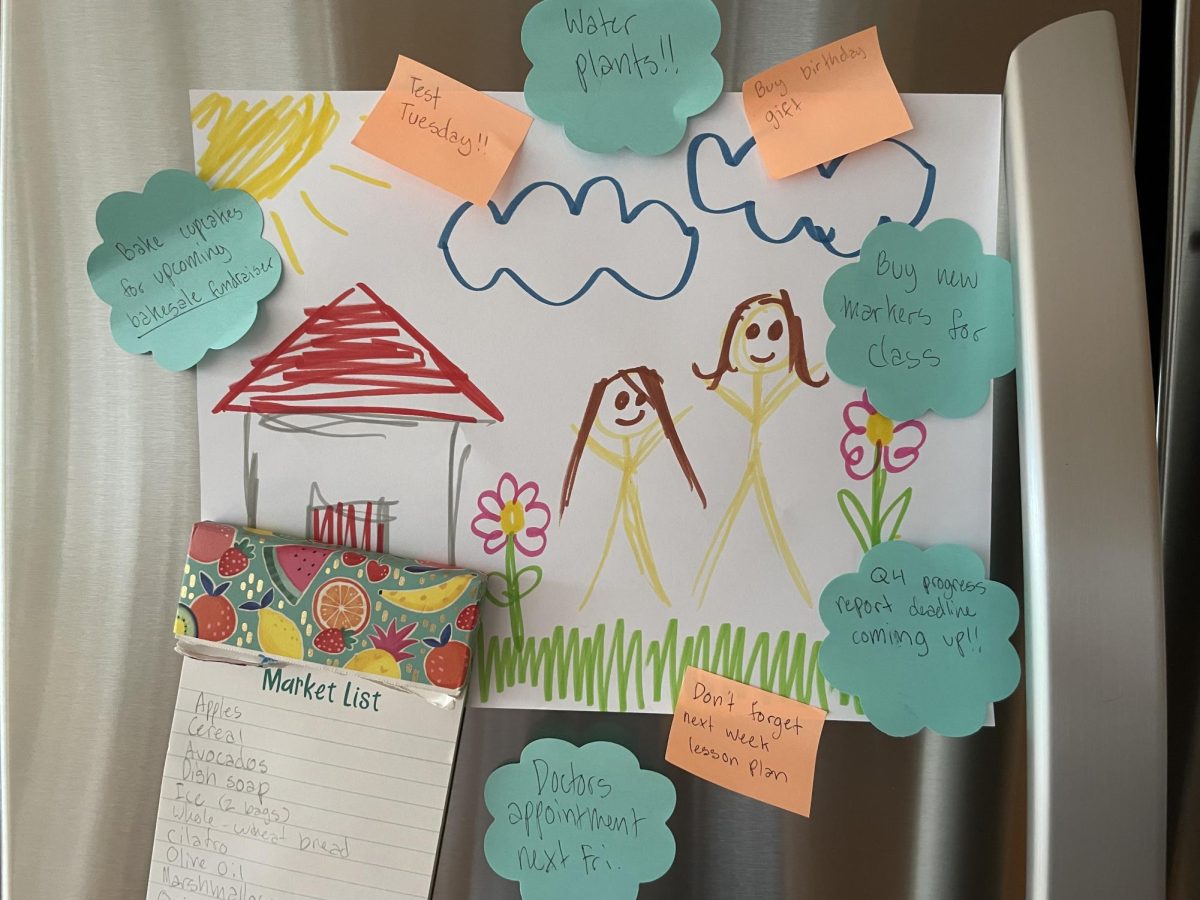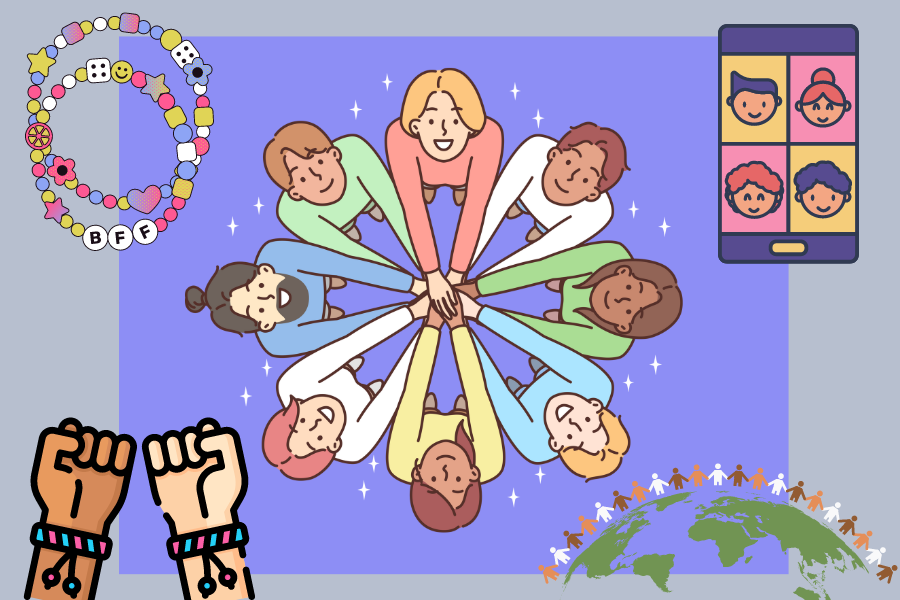This article appeared in the Fall 2023 magazine, Growing Up.
Plates and utensils clatter against the tables as the Redwood City Veterans Memorial Senior Center bustles with activity. Despite being a Thursday afternoon, seniors flock to the center for lunch and company while reminiscing about their younger years.
The Redwood City Veterans Memorial Senior Center services over 12,000 visitors a month by providing programs for nutrition, social services support, fitness, recreation, and education. These classes are designed to create community and increase the quality of life for elders. The Paw Print visited the center to allow seniors to reflect on their lives and share their perspectives. This is what they had to say.
Childhood:
Eighty years ago on the outskirts of San Francisco, near the Cow Palace, senior Leona Cassidy took her first steps of life among these crowded streets. Growing up in the projects, Cassidy’s childhood was marred by a violent and alcoholic mother in a poverty-stricken household. Yet, that didn’t stop her from enjoying outdoor hobbies with her twin brother and sister.
“I used to skate for hours,” Cassidy said. “Where we lived, there were a lot of hills. It was a lot of fun in those days. You didn’t have a lot of toys like you do now.”
During the 1950s following World War II, domestic violence, similar to what Cassidy experienced, was a common occurrence. According to the National Library of Medicine, 1950s society considered domestic violence a “private matter” that did not require police intervention. Left untreated, domestic violence festered throughout families, especially soldiers who struggled to adjust following their return from the war.
But soldiers weren’t the only ones to be changed by the war. Back at home, senior Susan Dugan recalled how everyday citizens’ daily lives shifted, with actions, like collecting aluminum foil from gum wrappers to give metal for war efforts, becoming a common activity. While the job was minimal, the patriotic spirit ran through the veins of Dugan and others who believed they were doing what they could for the war. Similarly, Cassidy remembered how mandatory blackouts were issued by the government when enemy planes circled nearby.
“I remember they announced blackouts, so you had a pull all your shades down and you couldn’t go outside,” Cassidy said. “But being kids, we used to peek right through the curtains to look out at the planes going overhead.”
When the war ended in 1945, joyous celebrations nationwide flooded city streets with Dugan and other small children wrapping crepe paper around their bikes and riding through parades.
“My grandmother worked at the Brooklyn Navy Yard, in the clothing department,” Dugan said. “So she had gotten me this little sailor suit. So I remember vividly waving my flag in the parade.”
For many children of the 1940s and 1950s, World War II was a defining feature of their experience growing up. Whether positive or negative, their childhood prepared them for the next phase of their lives: the workforce.
“I survived it,” senior Carolyn Malhahl said. “I’m much stronger for it. My mother wasn’t very pleasant to me. I was in the newspaper with her, as a child, because she abandoned me. I never saw my mother until I was 17. And I went to a very unpleasant foster home.”
Career:
The high rates of poverty during the 1950s, with about 30-39 million people living below the poverty line according to the U.S. Census Bureau, forced many children to grow up quickly. For Malhahl, her difficult childhood became a source of motivation to follow her dreams and land on the cover of a newspaper: this time, as a model.
“A lot of people thought I was a model [growing up],” Malhahl said. “I am in a Newsweek magazine.”
Cassidy’s childhood, similarly, was strongly influenced by her determination to enter the workforce early at age 16. At Balboa High School in San Francisco, where she attended, the school offered a work-study program to allow students to both work and go to school for equal parts of the day. Despite the challenges of balancing this schedule at a young age, the financial security it brought for Cassidy’s family and her future proved it to be a meaningful experience.
“I had to give up a lot of school because my mom didn’t work and my dad was not a professional man,” Cassidy said. “So it was kind of hard because we didn’t have money for anything. But I’m glad I did that because then when I graduated, I didn’t have to look for a job.”
While it might seem strange for many 21st-century teenagers, college wasn’t at the forefront of high schoolers’ minds during the 1950s. Like Cassidy, most students were trying to enter the workforce as soon as possible.
“When we were younger, hardly nobody went to college,” Cassidy said. “Nobody could afford it or they didn’t even talk about it that much. So the first thing you did was thinking about getting a job.”
For senior Catherine Krueger, her first job, as an office worker, began at a roofing and sheet metal company in western Pennsylvania. Four years later with no pay raise had Krueger contemplating other jobs, and a move to other states, to explore other options.
“[When I asked the boss’ son for a raise], he said to me, ‘Why should you [have a raise] when you haven’t given us a good day’s work from the day you started?’” Krueger said. “And I told him, ‘You say one more word and I’m picking up this ashtray and I’ll throw it at you.’ So I left with two weeks pay [for California with a friend].”
Cassidy and many of the other seniors maintain a can-do mentality despite the hardships of their time period and childhood. Like her journey across the U.S., Cassidy’s most valuable life experiences came from taking risks, something she hopes 21st-century teenagers strive for.
“The Greyhound bus had a $99 pass from coast to coast and I took that by myself,” Cassidy said. “I got tired of people saying, ‘Well we want to go’ but when the time came, nobody wanted to go. I said, ‘I’m going no matter what.’”








